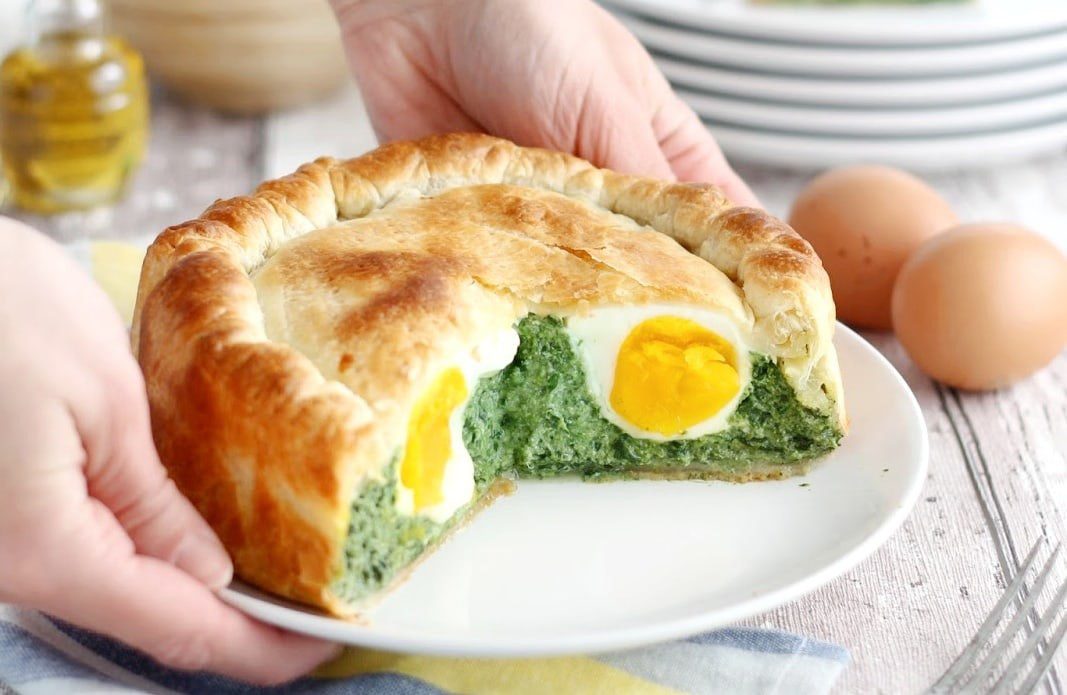TORTA PASQUALINA
Ligurian Easter vegetable pie symbolizes the celebration of resurgence, both spiritually and in the taste.
Flavors and Knowledge
Apr 16
{Image Attribution via Nonna Box}
Flavors + Knowledge is a reader-supported publication. To receive new posts and support my work, consider becoming a free or paid subscriber.
Happy Easter!
People have been eating eggs to commemorate springtime since before the birth of Christianity. Ancient Egyptians, Persians, and Romans regarded them as a symbol of new life and fertility and included them in their Spring festivals. This cultural imprint runs deep, as exemplified by that favorite old Latin proverb, you know the one, “omne vivum ex ovo,” or “all life comes from an egg.” (1)
Origins and History of Torta Pasqualina
In Ligurian cuisine, vegetable pies are very prevalent and prepared around Easter. In fact, in Italian, the word Pasqua translates to “Easter.” Several recipes regarding this type of pie abound in Renaissance cookbooks. The original torta Pasqualina includes a pastry made up of 33 very thin layers, a number chosen not by chance but precisely to symbolize the years of Jesus Christ.
Local mothers and grandmothers used only strictly Ligurian water, flour, salt, and extra-virgin olive oil. Nowadays, it is limited to about ten sheets, which are rolled very thinly and mixed without eggs but with flour, Ligurian oil, water, and salt. On the other hand, the filling involves the use of prescinseua, a particular soft cheese with a consistency halfway between yogurt and ricotta.
Because it is challenging to find outside Liguria, ricotta cheese becomes the apparent substitution. Other ingredients include chard or artichokes and marjoram and whole eggs, the last symbol of life and rebirth, the return of spring, and the triumph of life over death.
Read Flavors + Knowledge in the new Substack app
Now available for iOS
Get the app
Torta Pasqualina
Ingredients for 6
Ingredients for the pastry:
8 cups all-purpose flour
Four tablespoons of extra-virgin olive oil
1/2 teaspoon of salt
Lukewarm water
Ingredients for the filling:
3.3 pounds chard leaves ribs removed
3/4 cup plus one tablespoon grated Parmigiano-Reggiano divided
One tablespoon chopped fresh marjoram
1.1-pound prescinseua use ricotta if you can’t find it
Two tablespoons of all-purpose flour
Two tablespoons of extra-virgin olive oil
12 organic eggs
Eight tablespoons of butter melted
Salt + Black pepper to taste
Vegetable oil to grease the pan and the sheets
Procedure
Pour the flour into a bowl and add the salt, oil, and water to obtain a soft and smooth dough. Divide the dough into 33 parts and let it rest covered with a cloth for 30 minutes.
In the meantime, wash the chard leaves, chop them finely, and cook them in boiling salted water. Once ready, drain and squeeze them, put them in a large bowl, and add the grated cheese and marjoram.
Drain the whey from the prescinseua and add the flour, oil, tablespoon of grated cheese, salt, and pepper.
Take 13 balls of dough and roll them out with a rolling pin very thinly, brush them with oil on both sides, and place them on top of each other in the pan.
Then spread the chard over the top, drizzle with oil, and cover with prescinseua.
Use a spoon to create 12 divots, then crack an egg into each and season with a pinch of salt and melted butter.
Roll out the remaining 20 sheets, brush each with oil, and gently layer them on the pie. Finally, roll up the edges to form the crust edge and brush the surface with oil when finished.
Bake at 400 F for 50 minutes. Serve hot or cold.
Recipe and heading image courtesy of NonnaBox
Thanks for reading. Eat safe and wear a mask! Ciao Chef W
Flavors + Knowledge Podcast
Flavors + Knowledge Newsletter
SAPERE + SAPORI Italian Newsletter
YouTube News, you can eat 24
Support Chef Walters Children’s Diabetes Foundation
Corporate Website with other businesses and Services
© 2022 Chef Walters Cooking School Unsubscribe
CWCS 162 Mayfield Avenue Cranston Rhode Island 02920













